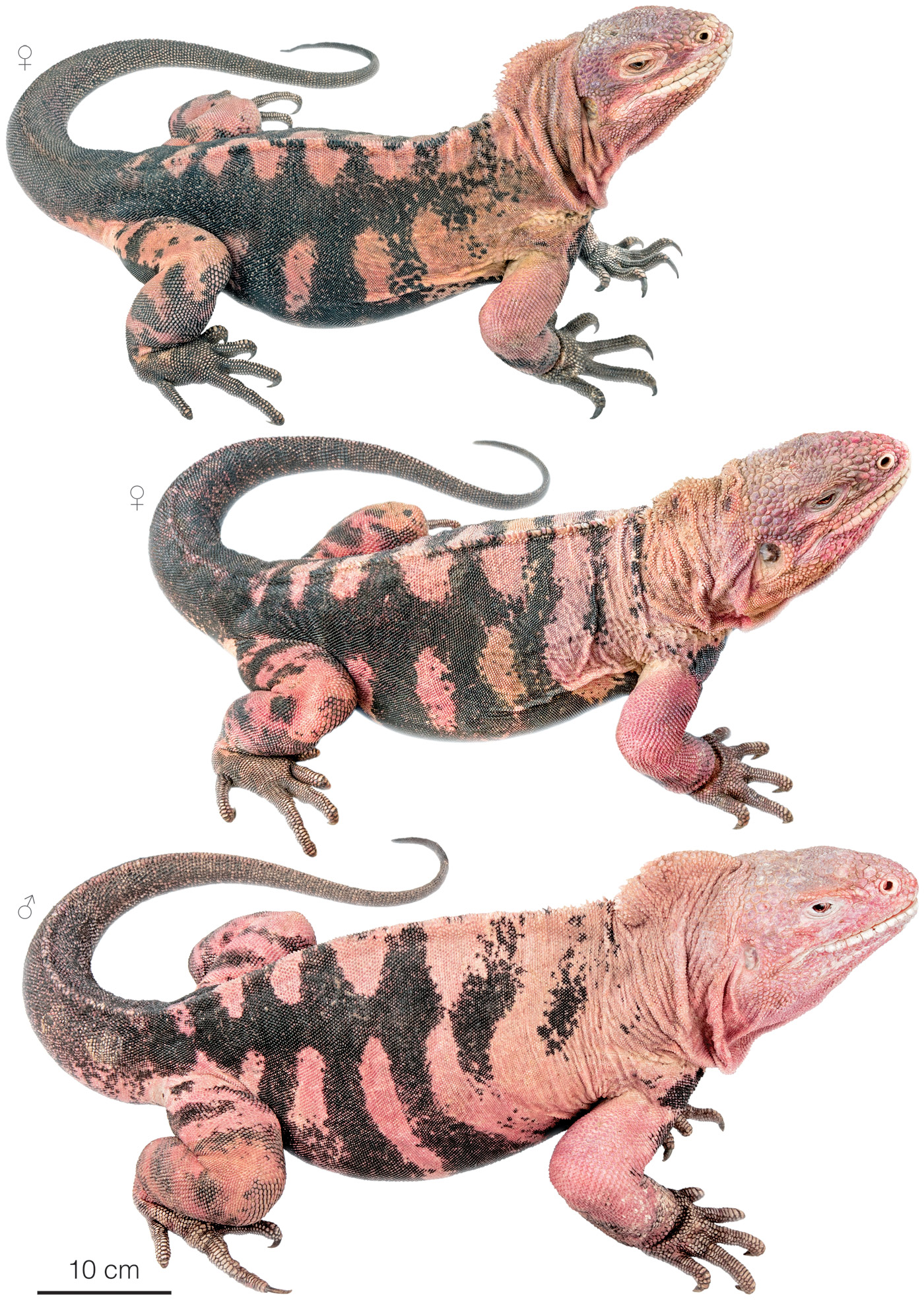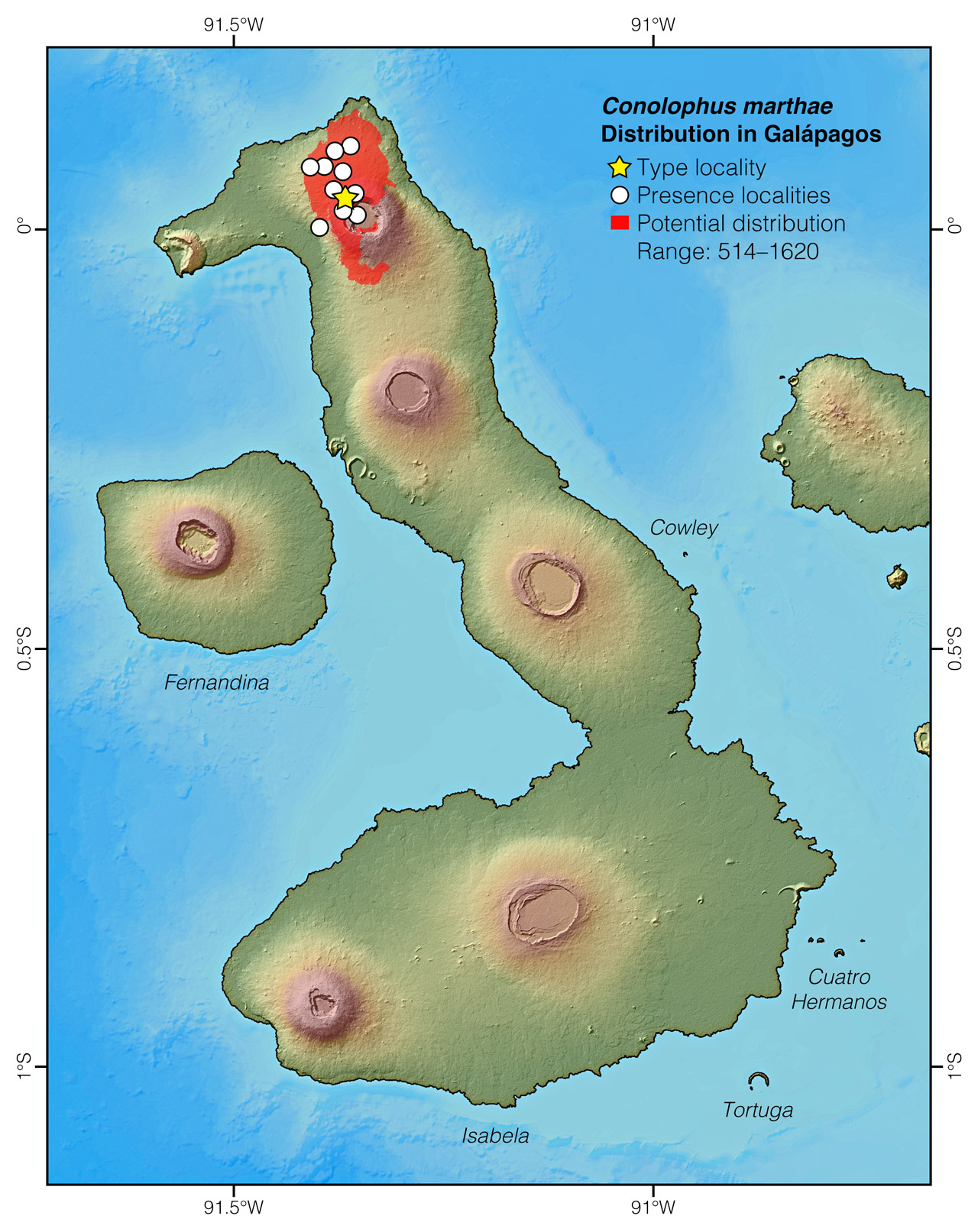Published October 10, 2019. Updated December 13, 2023. Open access. Peer-reviewed. | Purchase book ❯ |
Pink Land-Iguana (Conolophus marthae)
Reptiles of Ecuador | Sauria | Iguanidae | Conolophus marthae
English common names: Pink Land-Iguana, Pink Iguana, Galápagos Pink Iguana, Martha’s Land-Iguana.
Spanish common names: Iguana rosada, iguana de Martha.
Recognition: ♂♂ 108.4 cmMaximum distance from the snout to the tip of the tail. Snout–vent length=47.5 cm. ♀♀ 77.4 cmMaximum distance from the snout to the tip of the tail. Snout–vent length=49.4 cm..1,2 Conolophus marthae is unmistakable among reptiles in the Galápagos by its unique pink dorsum with a pattern of broad black bands and a black tail (Fig. 1).1–4 The neonates and juveniles are yellowish green with black blotches and reticulations. This species co-occurs with C. subcristatus, an iguana that lacks the distinctive pink coloration.3 Although the reason behind the Pink Iguana’s color is not fully understood, it is believed to be at least partially caused by the absence of skin pigmentation combined with a high number of anomalies in the nucleus of their red blood cells.4 These anomalies are thought to play a role in protecting the iguanas against the extreme solar radiation at the top of Wolf Volcano.

Figure 1: Individuals of Conolophus marthae from the northern rim of Wolf Volcano, Isabela Island, Galápagos, Ecuador.
Natural history: Conolophus marthae is a diurnal and terrestrial iguana inhabiting the dry grasslands and deciduous forests of Wolf Volcano,1–4 where it lives side by side with the Galápagos Land-Iguana (C. subcristatus). Adults of the Pink Land-Iguana are most active during sunny weather,3 basking at ground level close to their 2–3 m deep burrows, to which they frantically retreat if threatened.3 At night and on cold days, they hide in these same burrows.3 Their diet is made up of both native and introduced plants, including mostly (~48%) shrubs, but also herbs (~37%), grasses, and cacti.3 Potential or confirmed predators of young Pink Land-Iguanas include feral cats, rats, and hawks.4 When cornered, these strong and robust reptiles bite and strike with the tail.3 Adult males defend their territories by bobbing their heads or fighting with intruders.1–4 Gravid females contain 4–7 eggs and presumably lay them at the end of the rainy season.5,6 Hatchlings and juveniles, unknown before 2022, are semi-arboreal.
Conservation: Critically Endangered Considered to be facing imminent risk of extinction..6 Conolophus marthae is listed in this category because there is only one population composed of approximately 192 mature individuals restricted to an area no greater than 15 km2. Pink Land-Iguanas face several threats including predation of eggs and hatchlings by introduced predators and competition with the co-occurring C. subcristatus.3 Volcanic eruptions are also a serious threat to the species.5,6 Wolf Volcano is in constant activity, with its last eruption recorded in May 2015. Perhaps the most worrisome observation regarding the Pink Land-Iguana is that records of juveniles in the wild are extremely rare; thus, the long-term viability of the species is in question and a captive breeding program should be seriously considered.
Distribution: Conolophus marthae is endemic to an area of approximately 10.9 km2 on the northern slopes of Wolf Volcano, Isabela Island, Galápagos, Ecuador (Fig. 2).

Figure 2: Distribution of Conolophus marthae in Galápagos. The star corresponds to the type locality: northern rim of Wolf Volcano. See Appendix 1 for a complete list of the presence localities included in the map.
Etymology: The generic name Conolophus comes from the Greek words konos (=cone) and lophos (=crest),7 and refers to the cone-like scales that compose the dorsal crest in species of this genus. The specific epithet marthae honors Martha Rebecca Gentile, the second daughter of Gabriele Gentile, one of the biologists who described the Pink Land-Iguana.1
See it in the wild: The only known population of Conolophus marthae is located on a remote volcano inaccessible to tourism. Researchers and members of the Galápagos National Park may visit the habitat of the Pink Land-Iguana, but only in the context of a scientific expedition or a conservation action.
Special thanks to Nicolas Devos and Mike McAteer for symbolically adopting the Pink Land-Iguana and helping bring the Reptiles of Ecuador book project to life.
Click here to adopt a species.
Acknowledgments: This species account is dedicated to Carly Jones and Casey Klebba, founders of MiniFund, in recognition of their support of scientific field studies and conservation programs throughout the world. The expedition needed to create the white-background images of Conolophus marthae for the Reptiles of Galápagos book was funded by Minifund.
Authors: Alejandro ArteagaaAffiliation: Fundación Khamai, Reserva Arlequín, Ecoruta Paseo del Quinde km 56, Santa Rosa de Mindo, Pichincha 171202, Ecuador. and Juan M GuayasaminbAffiliation: Universidad San Francisco de Quito, Quito, Ecuador.
Academic reviewer: Miguel VencescAffiliation: Technische Universität Braunschweig, Braunschweig, Germany.
Photographer: Jose Vieira,dAffiliation: Tropical Herping (TH), Quito, Ecuador.,eAffiliation: ExSitu, Quito, Ecuador.
How to cite? Arteaga A, Guayasamin JM (2023) Pink Land-Iguana (Conolophus marthae). In: Arteaga A, Bustamante L, Vieira J (Eds) Reptiles of Ecuador: Life in the middle of the world. Available from: www.reptilesofecuador.com. DOI: 10.47051/LGCF9787
Literature cited:
- Gentile G, Snell HL (2009) Conolophus marthae sp.nov. (Squamata, Iguanidae), a new species of land iguana from the Galápagos Archipelago. Zootaxa 2201: 1–10. DOI: 10.11646/zootaxa.2201.1.1
- Márquez CM, Muñoz EA, Gentile G, Tapia WH, Zabala FJ, Naranjo SA, Llerena AJ (2010) Estado poblacional de las iguanas terrestres (Conolophus subcristatus, C. pallidus, y C. marthae: Squamata, Iguanidae), Islas Galápagos. Boletín Técnico, Serie Zoológica 6: 25–43.
- Arteaga A, Bustamante L, Vieira J, Tapia W, Guayasamin JM (2019) Reptiles of the Galápagos: Life on the Enchanted Islands. Tropical Herping, Quito, 208 pp.
- Gustavino B, Terrinoni S, Paglierani C, Gentile G (2014) Conolophus marthae vs. C. subcristatus: does the skin pigmentation pattern exert a protective role against DNA damaging effect induced by UV light exposure? Analysis of blood smears through the micronucleus test. IUCN SSC Iguana Specialist Group Meeting, Puerto Ayora, Ecuador.
- Gentile G, Márquez C, Snell HL, Tapia W, Izurieta A (2016) Conservation of a new flagship species: the Galápagos Pink Land Iguana (Conolophus marthae Gentile and Snell, 2009). In: Angelici F (Ed) Problematic Wildlife. Springer International Publishing, Cham, 314–336.
- Gentile G (2012) Conolophus marthae. The IUCN Red List of threatened species. Available from: www.iucnredlist.org. DOI: 10.2305/IUCN.UK.2012-1.RLTS.T174472A1414375.en
- Brown RW (1956) Composition of scientific words. Smithsonian Books, Washington, 882 pp.
Appendix 1: Locality data used to create the distribution map of Conolophus marthae in Ecuador (Fig. 2). Go to the section on symbols and abbreviations for a list of acronyms used. Asterisk (*) indicates type locality.
| Country | Province | Locality | Source |
| Ecuador | Galápagos | Inner rim of Wolf Volcano | Loreti et al. 2020 |
| Ecuador | Galápagos | NW rim of Wolf Volcano, 2 km NW of | Loreti et al. 2020 |
| Ecuador | Galápagos | NW rim of Wolf Volcano* | Gentile & Snell 2009 |
| Ecuador | Galápagos | NW Slope of Wolf | Márquez et al. 2010 |
| Ecuador | Galápagos | Punta Albemarle, 11 km SW of | Loreti et al. 2020 |
| Ecuador | Galápagos | Punta Albemarle, 7 km SW of | iNaturalist; photo examined |
| Ecuador | Galápagos | Western rim of Wolf Volcano | Loreti et al. 2020 |
| Ecuador | Galápagos | Western slope of Wolf Volcano | Márquez et al. 2010 |
| Ecuador | Galápagos | Wolf Volcano Camp 2 | Arteaga et al. 2019 |
| Ecuador | Galápagos | Wolf Volcano Camp 3 | Arteaga et al. 2019 |
| Ecuador | Galápagos | Wolf Volcano Camp 4 | Arteaga et al. 2019 |